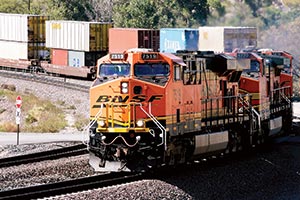Shippers Spur Competition Between Trucks, Railroads

This story appears in the Nov. 28 print edition of Transport Topics.
Shippers of bulk freight expect prices to rise on railroads next year, but they could have greater control in contract negotiations because of competition from trucking with intermodal rail, according to a Nov. 16 report from RBC Capital Markets.
The global investment bank polled 55 large-scale shippers in the United States and Canada about railroad rates, volumes, service and how they decide which transportation mode to use. While freight volumes are expected to rise in 2017, shippers also said they are expecting better service and better communication with Class 1 railroads, RBC analyst Walter Spracklin found.
Expectations on pricing varied widely. Seventy-four percent of shippers surveyed predicted rates will climb by as much as 6% in 2017. Yet among all participants, the average expectation was a 1.6% increase next year, down from the 2.5% jump predicted for 2016.
“The softer rate outlook reflects intentions of shippers to negotiate more strongly given the weak demand backdrop and excess rail capacity, [as well as] competitive pressures from trucking,” Spracklin said. “In the near term, we expect aggressive competition against rail on the short haul.”
Jay Roman, president of Escalation Consultants, said the balance of power in negotiations has tipped toward shippers with alternatives.
“Let’s say I’m shipping from Mississippi to California, and I’m captive to Norfolk Southern [the only nearby option]. If I can truck it to New Orleans and put it directly on Union Pacific, then Norfolk Southern could lose my business altogether,” he said. “If the rates are too high going to a [switch-over] with another railroad, then I’m encouraging the shipper to use alternative logistics options such as trucking to another railroad. The truckers are really going after the business.”
Trucking is an attractive option now because prices remain lower than in recent years. In total, 71% predicted that prices will either be flat or up by 3% in 2017. The average shipper forecast was for an all-but-flat 0.7% rate hike.
“In a bid to retain shrinking market share, truckers are compromising on rates, and shippers are taking notice,” Spracklin said. “During our discussions, many shippers noted intentions to negotiate hard at contract renewal and capitalize on the loose trucking capacity by tendering freight for bid.”
However, shippers also realize that the federal electronic logging device mandate starting in December 2017 could cause a drop in driver productivity, more turnover and smaller companies going out of business. This, in turn, would decrease truck availability and increase overall rates, according to the report.
Among the 15 surveyed shippers that are putting freight up for bid in 2017, the majority cited pricing as a primary motivator and quality of service as a secondary consideration, according to the report.
“It suggests that shippers are increasingly searching for a balance of service and cost in order to enhance their supply chains,” Spracklin said. “This view is supported by the high level of importance that shippers place on execution metrics in their evaluation of rail service.”
“Rail shippers are putting [overall market share] up for grabs,” Escalation’s Roman said. “Some shippers say that once they go to truck, it’s very hard to go back to rail because the service is so much better with trucks.”
But James Mourafetis, senior vice president at Argo Consulting, said trucking has its own challenges with pay, turnover and regulation.
“Trucking has fundamen- tally been reduced to small-radius, density-related completion [last-mile delivery], which is eroding margins and ultimately damaging the industry,” he said.
Shippers cited consistent service and good communication as major factors in determining whether to shift modes. Nearly 40% of shippers chose consistent service as the most important metric. The number that identified communication as important rose to 18% from 14% a year ago, the report said. Respondents added to their concerns that railroads must do a better job at offering accurate, real-time data and faster response times.
BNSF Railway received the top grade among U.S. railroads due to consistent service and dedication to getting new customers, the report found. In total, 73% rated BNSF as good or excellent, up from 56% one year ago.
Union Pacific Corp.’s approval mark remained flat at 63%.
CSX Corp.’s approval ratings improved to 62% from 50% year-over-year. One shipper told RBC the communication was “a cut above the rest.”
However, Norfolk Southern Corp.’s approval ratings dropped 2 percentage points to 55%. One shipper said the service was spot-on or spot-off, and another added that there was “no flexibility in terms of car supply or online electronic services.”
Canadian National Railway and Canadian Pacific Railway received approval ratings between 55% and 65%, both double-digit increases, year-over-year.
Kansas City Southern Railway Co. wasn’t part of the survey.
Mourafetis added that the railroad companies are investing heavily in infrastructure to ensure that service levels won’t be interrupted when volume shifts back from truck.




